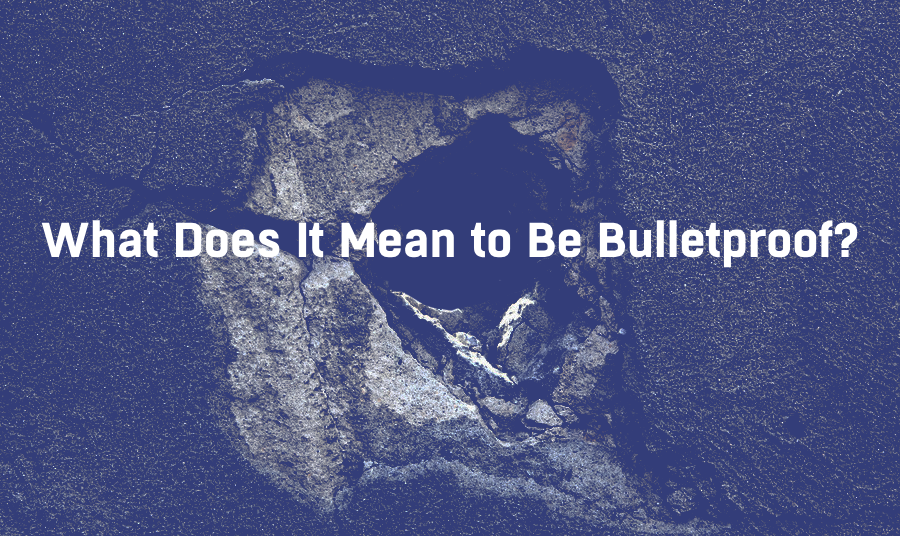"Bulletproof" gets thrown around a lot, but what does it actually mean? If you're wearing a bulletproof vest, what can you realistically expect it to stop? And how do you know if it's the right level of protection for you?
A lot of people have the wrong idea about what a bulletproof vest can do. Some think it'll stop any bullet, from any gun, in any situation. Others believe wearing one makes you completely safe. The truth is a bit more technical—and more realistic.
What Actually Stops a Bullet?
Outside of body armor, people often assume certain objects are "bulletproof" just because they look tough—things like brick walls, car doors, or concrete blocks. But reality doesn’t always match the movies.
Take a cinder block, for example. It might seem solid, but a round from an AK-style rifle can punch right through it. On the other hand, thick, dense metal components like engine blocks or steel I-beams can actually stop many types of bullets in their tracks.
People tend to overestimate what counts as bulletproof. Items like car doors, drywall, and even most walls in an American house won't reliably stop a bullet—especially not from a rifle. Even thicker-looking materials like wood or sheet metal might slow a round down, but they rarely stop it outright. As a matter of fact, taking cover behind moderately thick wood is generally a bad idea because of wood shrapnel. When a bullet strikes wood, especially at high velocity, it doesn’t just stop or lodge cleanly like it might in soft armor. Instead, the impact causes the wood to splinter and explode, sending sharp fragments outward. These fragments can be dangerous on their own, creating secondary injuries even if the bullet doesn't directly hit you.
On the flip side, there are objects that actually can stop bullets, especially rifle rounds. Engine blocks, steel plates, thick hardwood logs, and large chunks of concrete can all offer meaningful protection—but only under certain conditions. It depends on the round, the distance, and the angle of impact.
These kinds of battlefield lessons are important because they remind us that real-world bullet resistance is determined by a combination of material, density, and angle—not just thickness. That same principle applies to body armor, which brings us to how protective gear is actually rated.
The Real Definition of "Bulletproof"
First off, no vest makes you invincible. For example, there is no vest on earth capable of stopping a .50 caliber round. There are, however, levels to what a vest can protect against.
When people say something is bulletproof, they usually mean it can stop a bullet from penetrating. But not all bullets are created equal. There’s a huge difference between a .22 LR and a 7.62x51mm NATO round. That’s why we have a standardized rating system to define what kinds of rounds a vest can stop.
Understanding the NIJ Rating System
The National Institute of Justice (NIJ) is the organization that sets the standard for ballistic protection. Here’s a quick rundown of the most common NIJ levels:
-
Level IIA: Protects against 9mm and .40 S&W FMJ rounds. It’s light and flexible but not very common these days.
-
Level II: Stops 9mm and .357 Magnum. Still fairly lightweight but offers more protection than IIA.
-
Level IIIA: Stops .357 SIG and .44 Magnum. This is considered the highest level of protection you can get from soft armor alone. It’s a solid choice for law enforcement, security, and civilians who want serious coverage without hard plates.
-
Level III: This is where hard armor comes in. Level III plates are tested to stop 7.62x51mm NATO full metal jacket rounds. These are rifle rounds, so soft armor won’t cut it here.
-
Level IV: The highest rating. These plates are designed to stop armor-piercing rifle rounds, including .30-06 M2 AP rounds. Level IV is what you want if you're expecting to face serious threats.
BulletSafe's VP4 Advanced Vest comes rated at Level IIIA straight out of the box. That means you're covered against most handgun threats, including high-velocity rounds like .357 SIG and .44 Magnum.
The VP4 is also built to accept ballistic plates. Just slide in a BulletSafe Level IV plate, and now you've got protection against armor-piercing rifle fire. This modular setup that gives you flexibility without overcomplicating your gear.
So what does it mean to be bulletproof? It means knowing your threat level, choosing the right gear, and trusting equipment that’s been tested to take the hit.
Check out the BulletSafe VP4 and upgrade your protection with confidence.
FAQs about Bulletproof Protection
What objects can actually stop a bullet?
Some objects like engine blocks, steel plates, and thick concrete can offer meaningful protection against bullets under certain conditions.
What is the real definition of 'bulletproof'?
No vest makes you invincible, but there are levels to what a vest can protect against based on the NIJ rating system.
How does the NIJ rating system define bulletproof protection?
The NIJ sets the standard for ballistic protection and categorizes vests based on what kinds of rounds they can stop.
What are common misconceptions about bulletproof vests?
Many people overestimate what a bulletproof vest can do, thinking it can stop any bullet from any gun in any situation.
Why is understanding the limitations of bulletproof protection important?
Real-world bullet resistance is determined by a combination of material, density, and angle—not just thickness.

